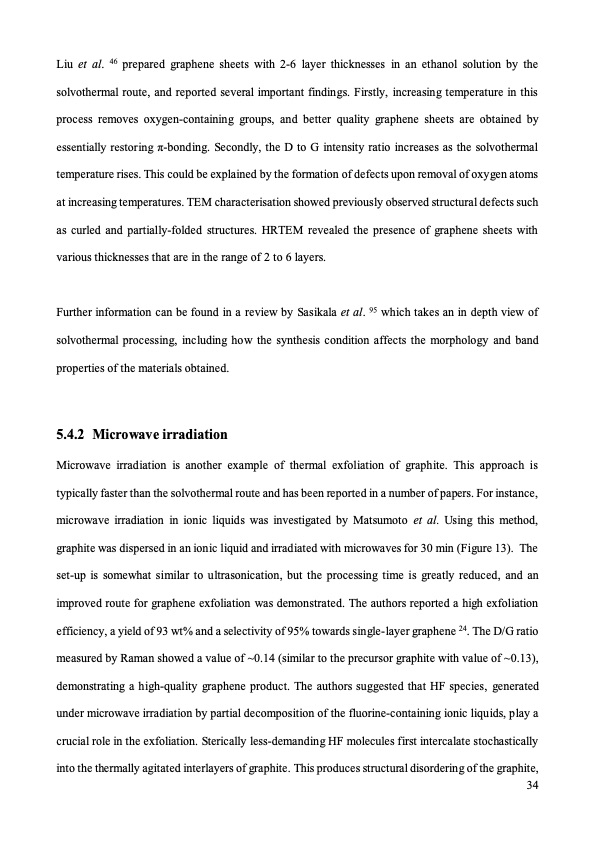PDF Publication Title:
Text from PDF Page: 034
Liu et al. 46 prepared graphene sheets with 2-6 layer thicknesses in an ethanol solution by the solvothermal route, and reported several important findings. Firstly, increasing temperature in this process removes oxygen-containing groups, and better quality graphene sheets are obtained by essentially restoring π-bonding. Secondly, the D to G intensity ratio increases as the solvothermal temperature rises. This could be explained by the formation of defects upon removal of oxygen atoms at increasing temperatures. TEM characterisation showed previously observed structural defects such as curled and partially-folded structures. HRTEM revealed the presence of graphene sheets with various thicknesses that are in the range of 2 to 6 layers. Further information can be found in a review by Sasikala et al. 95 which takes an in depth view of solvothermal processing, including how the synthesis condition affects the morphology and band properties of the materials obtained. 5.4.2 Microwaveirradiation Microwave irradiation is another example of thermal exfoliation of graphite. This approach is typically faster than the solvothermal route and has been reported in a number of papers. For instance, microwave irradiation in ionic liquids was investigated by Matsumoto et al. Using this method, graphite was dispersed in an ionic liquid and irradiated with microwaves for 30 min (Figure 13). The set-up is somewhat similar to ultrasonication, but the processing time is greatly reduced, and an improved route for graphene exfoliation was demonstrated. The authors reported a high exfoliation efficiency, a yield of 93 wt% and a selectivity of 95% towards single-layer graphene 24. The D/G ratio measured by Raman showed a value of ~0.14 (similar to the precursor graphite with value of ~0.13), demonstrating a high-quality graphene product. The authors suggested that HF species, generated under microwave irradiation by partial decomposition of the fluorine-containing ionic liquids, play a crucial role in the exfoliation. Sterically less-demanding HF molecules first intercalate stochastically into the thermally agitated interlayers of graphite. This produces structural disordering of the graphite, 34PDF Image | graphene production via nonoxidizing liquid exfoliation

PDF Search Title:
graphene production via nonoxidizing liquid exfoliationOriginal File Name Searched:
Graphene-R2-review.pdfDIY PDF Search: Google It | Yahoo | Bing
Salgenx Redox Flow Battery Technology: Power up your energy storage game with Salgenx Salt Water Battery. With its advanced technology, the flow battery provides reliable, scalable, and sustainable energy storage for utility-scale projects. Upgrade to a Salgenx flow battery today and take control of your energy future.
CONTACT TEL: 608-238-6001 Email: greg@infinityturbine.com (Standard Web Page)